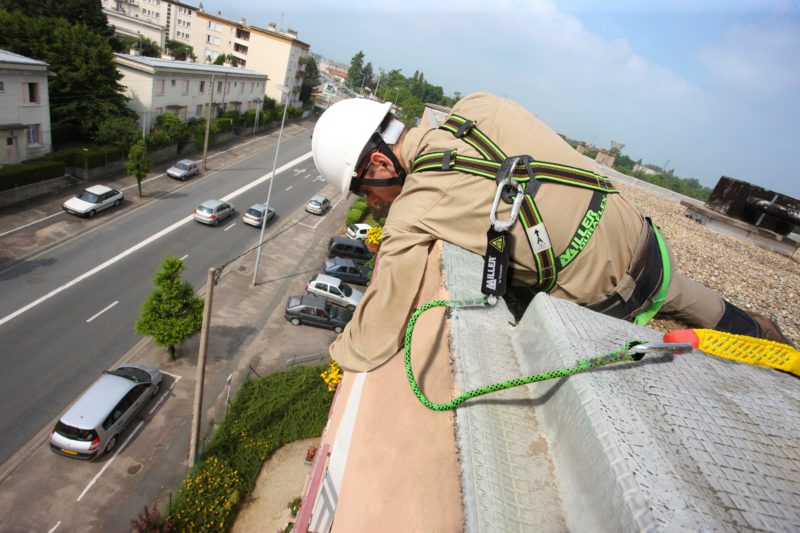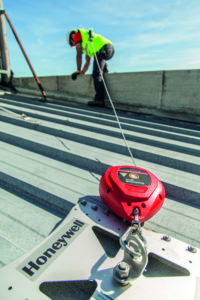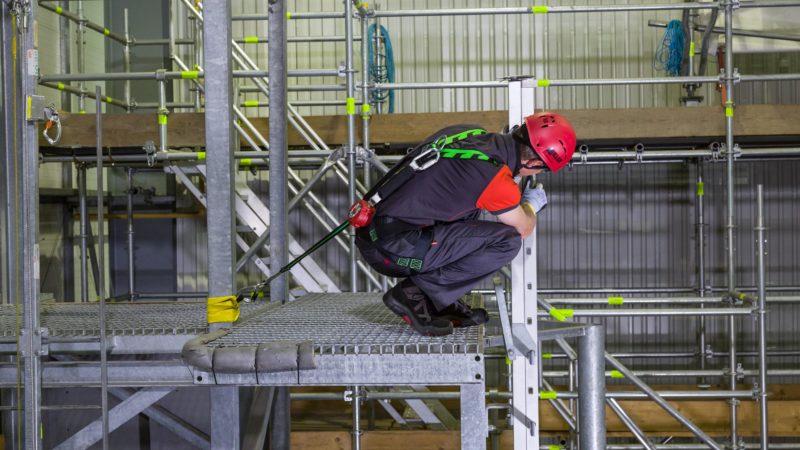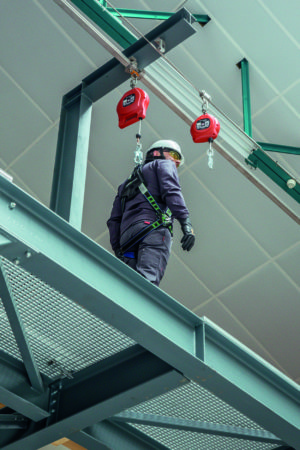Working at Height
How to protect workers from falls from height: In conversation with Corentin Barbieux
Corentin Barbieux, Product Manager of Fall Protection Solutions at Honeywell Industrial Safety, talks about the risks associated with working near edges and outlines the steps safety professionals should take to ensure workers have the optimal protection from falls from height.
The increase in urbanisation of the global population means that construction sites across the world are growing in volume, complexity and diversity. As a result the likelihood of workers having to conduct work at height, near edges, is also on the rise. Although there has been significant progress in the protection of workers at height in recent years, falls from height still represent one of the leading causes of death at work so safety professionals must remain vigilant.

Why is working near edges so risky?
Corentin Barbieux (CB): “Working at height, near edges, presents a higher risk of fatal accidents, namely falls from height, even with the correct safety equipment in place. Falls from height can occur in a split second, caused by a momentary lapse in concentration, tiredness, lack of special awareness, misplaced footing, a spontaneous reaction to an unexpected noise or loss of balance, which is further exacerbated when carrying heavy loads. It is also important to bear in mind that the danger level is not necessarily dependent on the height operated in. Falls from height that occur at relatively low heights can often lead to serious injuries, because the height has not been deemed significant enough to put safety precautions in place.”
What safety measures are recommended for workers operating near edges?
 (CB): “The first step should always be to try and avoid working at height altogether. If this is not possible, then collective protective equipment (CPE), such as barriers and netting, should take priority over personal fall protection equipment (PFPE), since it protects all workers equally at all times, without relying on the individual to take action. Additionally, safety levels are strongly enhanced by the use of PFPE, such as self-retracting lifelines (SRLs), which provides continuous attachment. This is especially important when collective measures have not yet been deployed, because their installation is underway or if the location prevents their use. These scenarios include workers temporarily operating on a flat roof to assemble scaffolding structures or performing maintenance on tall electrical pylons.”
(CB): “The first step should always be to try and avoid working at height altogether. If this is not possible, then collective protective equipment (CPE), such as barriers and netting, should take priority over personal fall protection equipment (PFPE), since it protects all workers equally at all times, without relying on the individual to take action. Additionally, safety levels are strongly enhanced by the use of PFPE, such as self-retracting lifelines (SRLs), which provides continuous attachment. This is especially important when collective measures have not yet been deployed, because their installation is underway or if the location prevents their use. These scenarios include workers temporarily operating on a flat roof to assemble scaffolding structures or performing maintenance on tall electrical pylons.”
What risks do edges pose to personal fall protection equipment?
(CB): “Workers using a shock-absorbing lanyards (SAL) or an SRL can wrongly assume that a lifeline of any kind will keep them fully protected in the event of a fall over an edge. Unfortunately, they can still be at risk if the lifeline has not been fully edge-tested or is not anchored properly. For example, if the worker falls from height, the webbing or cable will come into forceful contact with the edge. If it has not passed the edge-testing process and successfully demonstrated its resilience, it might not withstand the contact and could sever. Only a fully tested SRL or SAL will have proven resistance against edges comprised of different materials, such as metal, concrete or roofing felt, and can be relied on to safely arrest the fall.”
What components does effective Personal Fall Protection Equipment (PFPE) comprise of?
(CB): “PFPE is typically comprised of three key components: an anchorage connection, bodywear such as a harness, and a connecting device. All components are essential for protecting workers at height, particularly when working near edges. The European standard EN 795, which pertains PFPE, identifies five different anchor points of which the most suitable is to be selected: structural anchors, transportable temporary anchors, horizontal lifeline systems, horizontal rail systems or deadweight anchors. Bodywear usually comprises of a harness which has been specifically designed to distribute fall forces evenly around the chest, shoulders, upper thighs and pelvis to limit the risk of injury in case of a fall.
“While due consideration needs to be paid to both anchor point and bodywear, it is absolutely vital to ensure that the same attention is paid to selecting the correct connecting device. This is the critical link in PFPE that comes under the greatest strain during a fall. Connecting devices can be divided in two main types: SALs and SRLs. SALs are designed to arrest a fall, while minimising forces exerted both on the body of the harness wearer and the anchor point. SRLs, on the other hand, are ideal when fall clearance heights are a concern, as their working lengths range from 2m to over 20m. SRLs are usually made of webbing, galvanised steel cable or stainless steel wire rope.”

What needs to be considered when selecting and maintaining an SRL?
(CB): “When it comes to ensuring quality of this critical equipment, the importance of buying from reputable manufacturers cannot be understated. For SRLs to provide optimal protection, they need to be edge-tested in simulated real-life scenarios featuring a range of edge materials. When selecting equipment, safety professionals must ensure that it comes with documentary evidence of test performance and third-party certification, and that it complies with the relevant ISO quality standards.
“It is also important to regularly re-inspect equipment to make sure the protection doesn’t get compromised over time. Even if SRLs have been tested and approved for use near edges, wear and tear from continuous use can degrade the integrity of the equipment, putting workers at risk.”
How can safety professionals ensure that workers operating at height have protective equipment that is fit for purpose?
(CB): “When selecting SALs and SRLs, safety professionals should first review the company’s own fall protection strategy, which can have specific requirements in addition to those set by legislation. The type of work performed and the working environment must also guide the choice of equipment to ensure that it provides optimal functionality and protection. For example, a steel cable would be an optimal choice in an environment where heat, moisture, grease and dirt are present. However, this type of device would be unsuitable if the work took place in close proximity to high-voltage electrical currents, as the material would act as a conductor and heighten the risk of an electric shock. Finally, before making any purchasing decisions, it is essential to verify that SALs and SRLs will be fully compatible with other system components, such as anchorage points and harnesses, to ensure that the PFPE provides optimal safety.”
How can workers determine the right anchor point for their SRL?
 (CB): “Finding the best possible anchor point is crucial, as it can dramatically affect the performance of an SRL in case of a fall. When selecting an anchor point, the first considerations are the distance the SRL needs to operate, the location and the distance to the ground, also known as vertical clearance. Otherwise, if a fall occurs, the worker can hit the ground before the SRL can stop them.
(CB): “Finding the best possible anchor point is crucial, as it can dramatically affect the performance of an SRL in case of a fall. When selecting an anchor point, the first considerations are the distance the SRL needs to operate, the location and the distance to the ground, also known as vertical clearance. Otherwise, if a fall occurs, the worker can hit the ground before the SRL can stop them.
“Simply arresting the fall is not enough to protect the worker and controlling the way in which they fall is equally important. If the anchor point is positioned incorrectly (not directly overhead), workers can be exposed to the so called pendulum effect, where they swing back and forth during a fall. This can cause serious injuries if the worker hits nearby surfaces such as walls or protruding beams. In these cases, the angle between the worker and the anchor point is critical: the wider the angle, the longer it will take for the falling worker to reach a position directly beneath the anchor, at which point the SRL can arrest the fall. Safety can be improved by installing the anchor point directly above the work area and ensuring that the angle does not exceed 30 degrees.”
How is fall protection going to change in the future?
(CB): “Connectivity is enhancing the way safety is managed in different applications, with working at height being no exception. Leveraging technologies that enable employers and safety managers to monitor the on-site usage of critical equipment, such as PFPE, will help ensure that all workers have adequate protection at all times. Connected safety solutions, such as fall detection devices and alarms that automatically notify first-responders, enable quicker responses to accidents. At the same time, traditional personal protective equipment, such as harnesses, is increasingly including smart devices that collect information about the wearer and the environment. Harnesses, for example, can be embedded with sensors that can trigger a tightening of a SRL, when a worker moves too close to an edge. Recent advances in technology have also made it possible to integrate radio-frequency identification (RFID) sensors into PFPE, which enables safety managers to gather data from the workforce to guide equipment selection, training, usage and maintenance.”
How to protect workers from falls from height: In conversation with Corentin Barbieux
Corentin Barbieux, Product Manager of Fall Protection Solutions at Honeywell Industrial Safety, talks about the risks associated with working near
Safety & Health Practitioner
SHP - Health and Safety News, Legislation, PPE, CPD and Resources Related Topics
Workers facing uncertain future coupled with health and safety risks, new IOSH report says
Farming company fined £320k after a man died from fall
Roofing firm fined total of £880k after two workers injured


 (CB): “The first step should always be to try and avoid working at height altogether. If this is not possible, then collective protective equipment (CPE), such as barriers and netting, should take priority over personal fall protection equipment (PFPE), since it protects all workers equally at all times, without relying on the individual to take action. Additionally, safety levels are strongly enhanced by the use of PFPE, such as self-retracting lifelines (SRLs), which provides continuous attachment. This is especially important when collective measures have not yet been deployed, because their installation is underway or if the location prevents their use. These scenarios include workers temporarily operating on a flat roof to assemble scaffolding structures or performing maintenance on tall electrical pylons.”
(CB): “The first step should always be to try and avoid working at height altogether. If this is not possible, then collective protective equipment (CPE), such as barriers and netting, should take priority over personal fall protection equipment (PFPE), since it protects all workers equally at all times, without relying on the individual to take action. Additionally, safety levels are strongly enhanced by the use of PFPE, such as self-retracting lifelines (SRLs), which provides continuous attachment. This is especially important when collective measures have not yet been deployed, because their installation is underway or if the location prevents their use. These scenarios include workers temporarily operating on a flat roof to assemble scaffolding structures or performing maintenance on tall electrical pylons.”
 (CB): “Finding the best possible anchor point is crucial, as it can dramatically affect the performance of an SRL in case of a fall. When selecting an anchor point, the first considerations are the distance the SRL needs to operate, the location and the distance to the ground, also known as vertical clearance. Otherwise, if a fall occurs, the worker can hit the ground before the SRL can stop them.
(CB): “Finding the best possible anchor point is crucial, as it can dramatically affect the performance of an SRL in case of a fall. When selecting an anchor point, the first considerations are the distance the SRL needs to operate, the location and the distance to the ground, also known as vertical clearance. Otherwise, if a fall occurs, the worker can hit the ground before the SRL can stop them.
These photos are typical of library shots depicting potentially unsafe set up and use of fall protection equipment.
One would assume that experts could immediately see that the images do not portray the safe use of life preserving equipment, This would never happen on a properly planned and managed workplace.
Help me to learn please – what are you referring to?